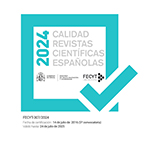The gender approach in the editorial policy of the greatest impact Communication journals in the Journal Citation Reports
Abstract
Since 2012, equality between the sexes and the integration of the gender perspective in research have been one of the priorities of the European Commission for the creation of the European Research Area. In order to eradicate the gender gap in scientific research and publication, the Gender Policy Committee of the European Association of Science Editors (EASE) promotes the SAGER (Sex and Gender Equity in Research) guidelines to incorporate systematic reporting by sex and gender in all phases of the research process. In our country, in the FECYT process of evaluating the editorial and scientific quality of the Spanish journals, in order to obtain the Mention of Good Editorial Practices in Gender Equality, there are also requirements related to the representation of women in editorial boards. The general objective of this research is to analyze the gender approach in the editorial policies of scientific Communication journals in the first quartile of the Journal Citation Reports in its latest edition. Specifically, the composition of the editorial board and the instructions to the authors are analyzed based on the information available on the web pages. Despite the fact that more than half of the analyzed journals include the SAGER guidelines in their instructions for submitting manuscripts, their low visibility, as well as the nature of recommendation or orientation with which they are presented in scientific publications, could limit their effective implementation.
Downloads
Article download
License
In order to support the global exchange of knowledge, the journal Revista General de Información y Documentación is allowing unrestricted access to its content as from its publication in this electronic edition, and as such it is an open-access journal. The originals published in this journal are the property of the Complutense University of Madrid and any reproduction thereof in full or in part must cite the source. All content is distributed under a Creative Commons Attribution 4.0 use and distribution licence (CC BY 4.0). This circumstance must be expressly stated in these terms where necessary. You can view the summary and the complete legal text of the licence.











